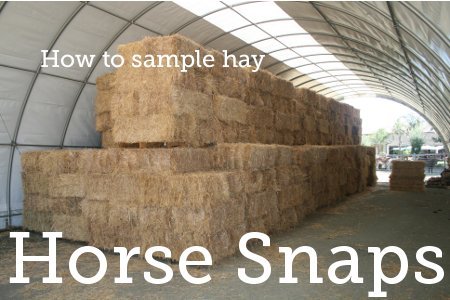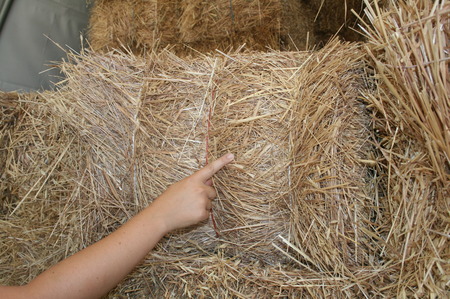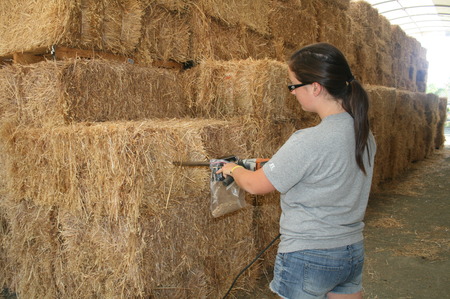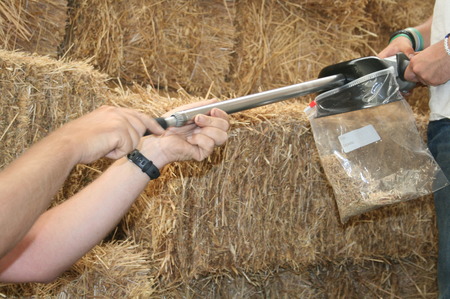-
Buy your hay in bulk? What's next?
Finally. Your hay barn is filled with loads of hay from your local farm hay supplier. It was expensive, but buying your hay in bulk and storing it close to your horses provides the best value.
Are you done? Not yet. Sampling and testing your hay will let you know if there are any missing essential minerals, vitamins or nutrients. To keep your horses healthy and in best condition, you can easily supplement for missing nutrients - but only if you know. Sampling and testing provides that information.
Sampling and testing hay is easy and affordable. For less than the cost of a veterinarian ranch visit, you can know for sure how your hay meets your horse's nutritional requirements. -
Tools required
These are the basic tools:- A hay probe
- A sample bag
- A drill
- Information from your test lab
Your analysis is only as good as your sample. The only way to get a good sample is to use the right tools (remember what your dad used to tell you.) A quality hay probe can be purchased for around $200.
You will also need a 1/2" drill. Battery powered will work fine, but if you are sampling a lot, use your gasoline powered generator with an electric drill.
A sample bag or envelope may be supplied by the test lab. We use a 1-gallon heavy-duty Ziploc freezer bag.
Before sampling, research and select a hay analysis test lab. Depending on the level of detail, you will spend around $15 to $30 for a basic hay analysis. Contact your lab before sampling for specific instructions. -
Be careful
This is the sharp tip of a typical hay probe. The tip of the probe is designed to bore through the hay with minimal effort. Be careful, the tip is sharp. Remember to save the rubber protector to avoid damaging the probe's tip and for your safety.
Whenever working with power tools, it is a good idea to wear safety glasses. -
Hay sampling tips
Most labs recommend sampling from 10 to 20 bales from various places within your hay stack or field. Ideally, the sampled bales will be representative of your entire hay purchase.
A sample consists of a mix of hays from the various bales that are in the stack.
Do not mix samples from different types of hay or different crops.
Most labs recommend that you use the probe to core the center of the bale from the end side. For the most accurate sample, be consistent and drill each bail in roughly the same location.
Contact the lab for advice on making a sample without a hay probe. -
Taking the hay sample 1
Take the probe and place the tip in the bale as instructed by your test lab. Start the drill and exert pressure on the probe so that it slowly enters the bail. Continue drilling until the probe is completely within the bale. -
Taking the hay sample 2
Reverse the drill and lightly pull to extricate the probe from the bale. Use the plunger rod to push the sample that is trapped in the tube into the collection bag. Continue to sample the specified number of bales, selecting bales that are in different locations in the stack. -
Prepare for sending to the test lab
Be sure to label the bag with type of hay, date and source location of the hay (e.g.Coyote Ranch Oat hay, April 3, 2012). Your report will contain this label so that the data can be associated with a particular hay stack, field or crop. If you are testing for vitamin levels, it is important to seal the sample bag and send it to the test lab as soon as possible. Some vitamins may lose potency over a period of time.
Fill out the lab supplied sample sheet and send the sample for analysis. Most test labs will send you the report by email or postal mail. -
What's next - Analysis
Depending on the lab, you will receive your hay analysis report in one or two weeks. The next step is to read the report and make decisions about any actions you should take to address any deficiencies.
Most labs provide analysis help either online, or as part of the report. You should also provide your veterinarian with a copy of the report and ask their advice.
You may also want to share the report with your hay supplier. If for no other reason, your hay supplier will know that you care about the quality of your hay and that you consider quality a part of your purchasing decision.
How to sample your horse's hay








